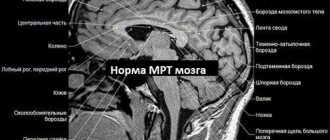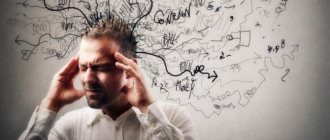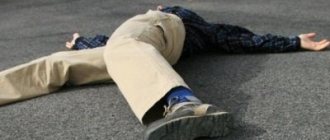Causes of apraxia
Apraxia occurs when the functions of certain parts of the cerebral hemispheres are impaired. This dysfunction can occur if damage in the brain occurs across the neural pathways that store memories of learned movements. A person with apraxia is unable to access this information. Apraxia can occur due to a head injury or a disease that affects the brain, such as:
- dementia
- tumors
- corticobasal degeneration
Apraxia often occurs in older adults due to neurological conditions such as ischemic stroke and dementia. If apraxia occurs after a stroke, the condition may improve within a few weeks.
Apraxia can also be genetically determined.
Classification of the disease
Based on the characteristics of the manifestation, clinicians distinguish the following types:
- Amnestic . The ability to carry out consistent actions at the request of a doctor develops. The patient simply forgets what he must do after the previous movement.
- Ideatorial . A person can perform any movement individually, but experiences problems when it is necessary to perform them in a certain sequence.
- Constructive . There is a violation of the ability to assemble a whole object from its component parts.
Forms of apraxia
Depending on the location of the brain lesion, neurologists usually distinguish the following forms of the disease:
- Motor apraxia. A person cannot perform a consistent series of actions, despite the desire.
- Ideomotor apraxia. Expressed as a violation of acquired skills. The patient is unable to reproduce complex movements.
- Frontal apraxia. Characterized by the patient's lack of ability to program and coordinate sequential movements.
- Cortical. It is expressed on the basis of persistent pathological changes in the motor cortex of the brain on the damaged side. The left-sided form is most often diagnosed.
- Bilateral. It is formed against the background of damage to the corpus callosum. This type of disease is only bilateral in nature and leads to disruption of the interaction between the two hemispheres of the brain.
Motor apraxia has its own classification:
- ideokinetic - the victim performs random actions, but cannot carry out purposeful movements;
- melokinetic - distortion of one or another manipulation occurs.
According to the type of memory loss, mental activity and other cognitive disorders, the following options are distinguished:
- Spatial apraxia. A person feels a state different from reality. The patient does not understand the difference between performing actions with open and closed eyes. The most common form.
- Oral apraxia. There is a loss of ability to realize speech function. The second name of the disease is apraxia of speech.
- Efferent apraxia. When the patient can perform familiar movements, but is unable to imitate what other people do.
- Articulatory apraxia. It is considered the most complex form of the disease, since the person cannot speak clearly. There is no paresis or paralysis of the articulatory organs.
- Kinetic apraxia.
- Kinesthetic apraxia. It is caused by the search for the necessary movements, which is noted when their voluntary action is violated.
- Akinetic. There is a lack of sufficient motivation to perform any manipulation.
- Regulatory apraxia.
Types of apraxia
Specific types imply the existence of the following types of disease:
- apraxia of walking - difficulties developing with movement while maintaining muscle strength in the lower extremities;
- apraxia of dressing;
- apraxia of the hand (alien hand syndrome) - the problem can be either unilateral or bilateral; the problem is that the upper limbs do not obey the person’s wishes;
- apraxia of the eyelids - the patient has difficulty opening the eyes;
- Gaze apraxia - characterized by the inability to move the eyes or fixate the gaze even for a short period of time.
The last two forms are combined into one type - oculomotor apraxia.
Localization of lesions in various types of apraxia
Types of apraxia
Types of apraxia manifest themselves in different ways:
Kinetic apraxia
People with kinetic apraxia cannot control their fingers, arms, or legs to make precise, coordinated movements. Although people with limb-kinetic apraxia understand how to use a tool such as a screwdriver and may have used it in the past, they are now unable to perform the same movement.
Ideomotor apraxia
People with ideomotor apraxia are unable to follow a verbal command to copy the movements of others or follow suggestions for movements.
Conceptual apraxia
This form of apraxia is similar to ideomotor apraxia. People with conceptual apraxia also cannot perform tasks that involve more than one step.
Ideatorial apraxia
People with ideation apraxia are unable to plan a specific movement. They have difficulty following sequences of movements such as dressing or bathing.
Buccofacial apraxia
People with buccofacial apraxia, or facial-oral apraxia, are unable to move their faces and lips.
Constructive apraxia
People with constructive apraxia are unable to copy, draw, or draw basic diagrams or shapes.
Oculomotor apraxia
Oculomotor apraxia affects the eyes. People with this type of apraxia have difficulty making eye movements on command.
Verbal apraxia
People with verbal or oral apraxia have difficulty making the movements needed to speak. They may have trouble producing sounds and understanding speech rhythms.
Symptoms of apraxia
The last century was marked by the discovery of the motor areas of the cerebral cortex. This introduced a completely new concept into neurology - apraxia. Although the first mention of it is believed to date back to 1871. Today, most human subjects do not know the concept of apraxia and what it is. The average individual does not know what the disease described is and how exactly it manifests itself. The described deviation cannot be attributed to an independent illness. It is rather a secondary manifestation of other pathologies.
The main signs of the disorder in question are the inability to regulate motor acts of the facial muscles, perform precise movements, the inability to copy, sometimes draw elementary figures, use tools properly, and the inability to put on wardrobe items.
Apraxia of walking is often determined by the following specific signs: excessive stooping, shuffling gait, sudden stop, inability to step over an obstacle. At the same time, individuals often do not realize their own unhealthy state. Sometimes signs of the abnormality in question may not bother subjects, being detected only during specific neurological studies.
So, the symptoms of apraxia are as follows:
- difficulties in reproducing sequential manipulations on command; patients often do not remember the sequence of some actions;
- difficulties in performing motor operations that require spatial orientation; in patients, the relationship between space and their own actions changes (spatial apraxia);
- walking in small steps, constrained gait;
- difficulty getting dressed;
- motor perseverations, expressed in the stable reproduction of individual elements of a motor operation and jamming on it (kinesthetic apraxia);
- difficulty opening the eyes.
The difference between apraxia and aphasia and dyspraxia
Symptoms of apraxia may be similar to those of two other conditions called aphasia
and
dyspraxia
. Aphasia usually results from damage to the cerebral cortex. Certain areas of the cerebral cortex, called Broca's area and Wernicke's area, are responsible for understanding and producing speech.
People with aphasia may have difficulty:
- in finding the right words to express yourself
- when reading and writing sentences
- in understanding words and grammar
Dyspraxia
is a mild form of apraxia, which people sometimes call developmental coordination disorder. It reduces a person's ability to perform some physical movements and can also affect speech.
People with dyspraxia may have symptoms such as:
- difficulties with balance
- clumsiness
- vision problems
- emotional or behavioral difficulties
- problems with social skills
- difficulties with reading, writing and speaking
- memory problems
Non-speech disorders in motor alalia article on speech therapy on the topic
Alalia is the absence or underdevelopment of speech due to organic damage to the speech areas of the cerebral cortex in the prenatal or early period of a child’s development.
Most researchers point to the pathology of pregnancy as the reasons leading to the occurrence of alalia. This may be more severe than usual toxicosis, threat of miscarriage, Rh factor incompatibility, infectious diseases of the mother during pregnancy (rubella, measles, tonsillitis, influenza with complications). Smoking, alcoholism and drug addiction of parents are indicated as harmful factors. The factor of adverse environmental impact has recently become especially relevant.
Motor (expressive) alalia
Motor alalia is a systemic underdevelopment of expressive speech of a central organic nature, caused by the immaturity of linguistic operations in the process of generating speech utterances with the relative preservation of semantic and sensorimotor operations.
Motor alalia is a complex syndrome, a complex of speech and non-speech symptoms, the relationships between which are ambiguous. In the structure of speech defects in motor alalia, the leading ones are language disorders.
Speech symptoms
Underdevelopment of speech in motor alalia is systemic in nature, covering all its components: phonetic-phonemic and lexical-grammatical aspects. Based on the prevailing characteristics, we can distinguish a group of children with predominant phonetic-phonemic underdevelopment (they are a minority) and a group with predominant lexical-grammatical underdevelopment. It is assumed that the first of the groups is caused by a leading lesion of the lower sections in the central motor area of the cortex of the dominant hemisphere, where irritations from the muscles, ligaments that arise when performing articulatory movements, or in the general muscles (when performing other movements) are concentrated. The second group is caused by damage to the anterior parts of the motor area of the cerebral cortex (the lower parts of the motor-premotor zone and the active speech zone, located in the posterior parts of the inferior frontal gyrus).
The development of the pronunciation system in children with alalia is characterized by qualitative and quantitative originality, which is revealed to one degree or another in all children and at each stage of speech development.
A child with alalia does not develop fine motor coordination of the speech apparatus. Violation of the analytical-synthetic activity of the speech motor analyzer is of a different nature: oral apraxia, violation of sequence, switchability, etc. There is a search for articulation, inability to perform a certain articulatory movement or action (a set of sequential movements), difficulties in mastering sequence and switchability. The leading factor in these cases is a motor disorder, which determines the speech articulatory disorder. In this case, due to kinetic or kinesthetic apraxia, the phonetic and phonemic systems suffer.
With alalia, the child cannot find the correct sequence of sounds in a word, words in a phrase, and cannot switch from one word to another. This leads to an abundance of paraphasias, rearrangements, perseveration and indicates a violation of the mobility of the main nervous processes, stagnant foci of excitation or inhibition in the speech motor analyzer. As a consequence of this, a child with motor alalia, with good hearing and sufficient understanding of speech, in the absence of paralysis and severe cuts in the articulatory muscles, does not develop independent speech, remaining for a long time at the level of individual sounds and words.
The greater the degree of underdevelopment of the cerebral cortex, the more profound and severe the immaturity of the speech function. There is a direct connection between violations of articulatory praxis and the organization of speech movements, and therefore the expressive side of speech, on the one hand, and with the perception and understanding of speech, on the other.
Often, due to the unclearness of sound perception, children grasp only individual elements of a phrase and cannot connect them into a single semantic structure. This limitation of understanding is a secondary manifestation of the main defect - underdevelopment of one’s own speech.
The vocabulary of children with motor alalia develops slowly, distortedly, is used incorrectly in speech practice, is limited to everyday topics, is qualitatively inferior, the child cannot explain the meaning of words, and does not know how to use word-formation means.
Structural agrammatism is understood as a violation of the number and dynamic linear sequence of words in a sentence, a violation of word order. More often, this type of agrammatism is observed with more severe speech immaturity. If there is insufficient lexico-grammatical and phonetic means, the child develops a facial-gestural form of communication.
The lack of formation of speech operations (conception, programming, selection and synthesis of speech material) is expressed in the fact that he cannot formulate a thought lexically and grammatically correctly. The lexico-semantic and lexico-grammatical organization of the sentence is incorrect, it reflects the inferiority of the subject connections perceived by the child in the environment. This is regarded as semantic agrammatism: diffuse expansion of the meaning of a word, substitutions of an associative nature, etc.
Motor alalia is heterogeneous in its manifestations. The unevenness of violations of the language system is revealed: alalia with a predominant immaturity of the phonemic or grammatical level of the language system and alalia with a relatively uniform immaturity of all language systems.
Non-speech symptoms of motor alalia
Children with alalia show immaturity not only of speech activity, but also of a number of motor and mental functions. With motor alalia, neurological symptoms of varying severity are observed: from blurred manifestations of brain dysfunction and isolated signs of damage to the central nervous system to pronounced neurological disorders (paresis), especially the pyramidal and extrapyramidal systems.
General motor awkwardness of children, clumsiness, incoordination of movements, slowness or disinhibition of movements are revealed. Fine motor skills of the fingers are especially difficult. Some children are disinhibited, impulsive, chaotic in their activities, hyperactive, while others, on the contrary, are lethargic, inhibited, inert, and unspontaneous.
Children have underdevelopment of many higher mental functions (memory, attention, thinking, etc.), especially at the level of volition and awareness.
With alalia, speech thinking is formed in a unique way, which requires full-fledged linguistic generalizations.
Children with alalia have a poverty of logical operations, a decreased ability for symbolization, generalization and abstraction, a violation of oral and dynamic praxis, acoustic gnosis, i.e. they have reduced intellectual operations that require speech. The insufficient level of generalization is manifested in play actions, lack of formation of role commands, and skills of joint (especially plot-role) play of children.
Low speech activity limits the stock of general concepts. However, in most cases, in the picture of the uniqueness of the higher nervous activity of children with alalia, intellectual disorders are secondary.
Along with the defects common to motor alalia, manifestations characteristic of its specific form are observed. It is these defects that form the core of the disorders, which in the initial stages of speech development cannot always be detected immediately, since they turn out to be masked by concomitant disorders.
The main directions and content of correctional and pedagogical work for motor alalia
Alalia is a medical, psychological and pedagogical problem. The field of speech therapy is to determine the principles and methods of correctional interventions aimed at developing the child’s speech and personality. Systematic long-term speech therapy work in some cases provides means sufficient for the child’s verbal communication, but sometimes only the most elementary speech. Depending on the nature of the disorder, this problem is solved differentially in relation to motor and sensory alalia.
An integrated approach to the formation of speech during alalia directs attention to the formation of all functions of speech that contribute to its development and improvement of cognitive activity.
Comprehensive systematic work is being carried out on speech and personality as a whole, taking into account the patterns of development of speech function in ontogenesis and the patterns of language structure.
Systematic speech therapy work is aimed at filling gaps in speech development and preparing for further school education under special programs, or it is carried out in parallel with school education in addition to it. Overcoming speech underdevelopment is structured so that during the work there is a readiness to master school knowledge; speech therapy work can only be effective if it is carried out comprehensively against the background of active medication and psychotherapeutic treatment carried out by a neuropsychiatrist (neurologist, psychiatrist).
When working, different techniques and methods are used, which should not be considered in isolation, but in combination, as having a common focus in correctional and educational impact; tasks and content of work are determined depending on the child’s speech capabilities
The work is aimed primarily at creating mechanisms of speech activity: the formation of a motive, communicative intention, internal program of an utterance, its lexical layout, selection of lexical and grammatical means, grammatical structuring. To enrich speech practice, skills in the conscious use of knowledge are developed, and mastery of modeling speech operations is developed.
Standardization of methodological techniques is unacceptable; the selection of linguistic and didactic material and the determination of its sequence are variable.
Not only the specifics of speech underdevelopment are taken into account, but also the personality characteristics of each child, his interests, and compensatory capabilities. Neurotic layers in the child’s character are eliminated through educational influence, and work is carried out to educate a conscious, purposeful personality. The child’s traumatic environmental influences are eliminated, and he develops the correct attitude towards his own speech underdevelopment and towards working to overcome it. Speech is improved in conjunction with the development of sensory and general motor capabilities.
Attention is paid to the development of fine motor skills: children are taught to line, paint, hatch, tie knots, lay out patterns from mosaics and geometric materials, etc. It has been established that if children are lagging behind in the development of finger movements, then they are lagging behind in the development of speech. As you practice hand movements, the state of speech improves.
At the initial stages of work, the psychophysiological basis of speech is formed, attitudes towards activity and communication are developed, the child is brought to the need for communication, and the need for it develops. It is important to form the motivational basis of a statement in a child, to develop speech and mental activity, the functions of imitative activity and reflected (reproduced) speech.
Nurturing the motive for activity and organizing a speech program create the necessary basis, key links for the development of speech, which are not formed by themselves in a child with alalia. The main of these links are the development of the predicative system and mastery of the elements of grammatical structure.
Not only speech, but also non-speech disorders are overcome; processes of analysis, synthesis, attention, perception, generalization, opposition develop, which together form the necessary foundation for speech development. The child is taught to distinguish, name and systematize objects by shape, size, color; various games are used for this. Training is provided in identifying and naming the position of an object in relation to others (above, in the middle, etc.). When overcoming the immaturity of visual perception and spatial comparison, the formation of temporal and spatial representations, games with the child’s active movement in space, rearrangements, directed walking, etc. are used.
Work is underway to distinguish the details of figures and their holistic appearance, complex figures with a large number of elements are analyzed, comprehension of structures and the ability to design are developed. Operations of analysis, synthesis, generalization of non-speech material (comparison, juxtaposition, contrast, identification of similarities and differences of objects, comparison by characteristics - color, size, shape), establishment of cause-and-effect relationships create the necessary prerequisites for the formation of speech.
The use of rhythmics and logorhythmics is effective for the development of speech, when music, words and movement, combined in various exercises, form motor and speech motor activity, memory, and ensure that gaps in the rhythmic, speech and personal development of children are filled.
For the development of speech, it is necessary to practice communication at a level accessible to the child: operations with individual words (show, repeat, name), with phrases not united by a semantic context (understanding questions, answering them in an expanded form), with phrasal material united by a semantic context against the backdrop of an emotional and semantically significant situation for the child (ask for a toy, choose a type of activity, etc.), with a familiar picture, games using dialogic and then monologue speech, with or without support for clarity, etc. Gradually increasing volume and difficulty of lexical and grammatical material.
Work on speech is connected with the child’s objective and practical activity and is based on it. The child develops awareness of his own actions (I am sitting, walking, carrying) and the actions of others (Vova is sitting, walking, carrying; the ball has fallen; the lamp is on). As the child’s speech abilities develop, they are taught to construct coherent and complete explanations in the course of actions performed, about completed (report) and upcoming (planning) actions.
It is important to involve different analyzers - auditory, visual, tactile. The child must observe, listen to the name of an object or action, depict a designation or purpose with a gesture, name it himself, etc. As a result of this, additional connections arise in the child’s mind, the material is consolidated more firmly.
The effectiveness of work depends on the availability of visual material.
Regardless of the stage of work, the impact is directed to the entire speech system: expansion, clarification of the dictionary, formation of phrasal and connected speech, correction of sound pronunciation, but at each stage specific tasks and features of the content of the work are highlighted.
At the first stage of work, the main thing is the education of speech activity, the formation of a passive and active vocabulary that is accessible to understanding and reproduction. Work is being done on dialogue, a short simple story, uncommon, then common sentences, the psychophysiological prerequisites for speech activity and initial skills in a communication situation are being formed.
At the second stage, phrasal speech is formed against the background of increasing complexity of the vocabulary and phrase structure. Work is underway on the distribution of sentences, their grammatical design, on dialogue and narrative stories of a descriptive nature, and utterances are formed as the basic units of speech action.
At the third stage, the main thing is the formation of coherent speech - particularly complex communicative activities, communication skills, automation of grammatical structures.
At each stage, all aspects of speech activity are formed.
Various vocabulary work techniques are used: natural (demonstration of objects, actions, pictures, situations), verbal (correlating a word with known words by similarity, opposite), etc. A dictionary of different parts of speech is accumulated.
Of course, the child is not given any information on grammar; the work provides only practical acquaintance with the most frequent patterns of inflection and word formation, and sentence construction. The general procedure for working on any grammatical category is as follows: first, the child observes how the speech therapist constructs a certain model, then engages in imitative speech activity, using both an isolated grammatical form and a grammatical form in expanded speech. Agrammatism in one’s own speech is smoothed out by proactively overcoming impressive agrammatism.
The main task of the work is always kept in mind - the formation of the process and means of communication in the child. From dialogue in interpersonal communication they gradually move to monologue speech, developing incentives for it (to report important news, talk about what they saw, etc.); In this case, an important stimulus is the child’s interest in the environment; active speech behavior is developed in situational communication. The level of general orientation of the child in the environment and the development of speech abilities are always taken into account, contact and the need for communication develop. The initiative for verbal communication gradually passes from the speech therapist to the child.
Children with alalia begin to learn to read and write relatively early, this expands their speech capabilities. Read and written material is better consolidated and the formation of speech activity is ensured. Literacy helps a child master the structure of words and phrases; through reading and writing, he controls and corrects his speech.
For children with alalia of school age, a special organization of education is required, which is carried out in a school setting for children with severe speech impairments.
Many children with alalia receive initial help from speech therapists in children's clinics and psychoneurological dispensaries.
Teaching the speech of the most difficult children is more successful in a hospital setting, where it is possible to purposefully carry out the entire complex of medical, psychological and pedagogical measures aimed at developing the speech and personality of a child with alalia, to ensure contact in the work of a speech therapist, teacher, doctor, psychologist. The same work is carried out in centers for social assistance to families and children.
Speech therapy work is effective only with systematic specific treatment of the child.
A powerful source of speech development for such children is their communication with normally speaking people. Although communication is not considered the only factor determining the level of development of speech and cognitive activity, the most effective is the formation of speech in the process of communication based on the maximum development of communication activity and cognitive abilities of children.
The work is carried out mainly in a group, while children's imitation is used, an emotional background and the effect of competition are created, children develop the skill of collective work, which is important for future schooling and social adaptation.
The work is individualized, depending on the speech and personal characteristics of the children. Differentiated work methods make the correctional impact most effective.
Positive dynamics in alalia are revealed by taking into account the following factors: early recognition of underdevelopment, timely prevention of secondary deviations, taking into account normal ontogenesis, systematic impact on all components of speech with a primary emphasis on overcoming lexical and grammatical underdevelopment, differentiated approach to children, speech formation with simultaneous impact on sensory-intellectual and affective-volitional sphere, the unity of the formation of speech processes, thinking and cognitive activity, etc.
Systematic speech therapy work is aimed at filling gaps in speech development and preparing for further school education under special programs, or it is carried out in parallel with school education in addition to it. Overcoming speech underdevelopment is structured so that during the work there is a readiness to master school knowledge; speech therapy work can only be effective if it is carried out comprehensively against the background of active medication and psychotherapeutic treatment carried out by a neuropsychiatrist (neurologist, psychiatrist).
Bibliography
- Becker K.-P., Sovak M. Speech therapy. - M., 1981.
- Grinshpun B.M. On the principles of speech therapy work at the initial stages of speech formation in motor learners. //Speech and voice disorders in children. - M., 1995.
- Gurovets G.V., Mayevskaya S.I. Genesis, clinic and main directions of work for motor alalia. //Underdevelopment and loss of speech, issues of theory and practice. - M., 1985.
- Kovshikov V.A. On the terminology of “motor alalia”. //Training and education of children with speech disorders. - M., 1992.
- Speech therapy: a textbook for students. Defectology Faculty of Pedagogical Institutions of Higher Educational Institutions/Ed. L.S.Volkova. – 5th ed. M.: VLADOS, 2004.
- Mastyukova E.M. Ontogenetic approach to the structure of the defect in motor allalia. // Defectology, No. 6, 1981.
- Smirnova I.A. Speech therapy diagnostics, correction and prevention of speech disorders. Alalia, dysarthria, OHP: Educational and methodological manual for speech therapists and speech pathologists. - St. Petersburg: “CHILDHOOD-PRESS”, 2004.
- Shakhovskaya S.N. Alalia. //Speech disorders in children and adolescents. - M., 1999.
- Shakhovskaya S.N. The use of visual aids in the development of speech in children with alalia. //Speech disorders and methods for their elimination. - M., 2000.
- Shakhovskaya S.N. Speech therapy work on the formation of the grammatical structure of speech of children suffering from motor alalia. //Speech pathology. - M., 2001.
Diagnostics and tests
To diagnose apraxia, a neurologist will take a detailed medical history of the person and examine all symptoms to determine the underlying causes. The neurologist will also try to rule out conditions such as motor weakness, aphasia or dyspraxia.
Your doctor may do tests to evaluate:
- verbal and non-verbal communication
- how people participate and function in certain activities
- coordination
- hearing and listening ability
Diagnostic tests may include both physical tests to measure motor coordination skills and language tests to test the ability to understand commands.
Apraxia - what is it?
Praxis.
Apraxia (AS) is a violation of purposeful actions, while maintaining its constituent elementary movements, and there are no motor disorders in the form of paralysis, hypokinesia or ataxia. It occupies a special place in neurology and speech therapy, since it often requires the help of a speech therapist, neurologist, and neuropsychologist at the same time.
AS is possible in one or both hands, in the oral muscles, when walking, etc.
Factors necessary for purposeful movements (praxis):
- Preservation of the afferent and efferent basis of movements;
- Preservation of visuospatial relationships;
- Programming and control when organizing praxis.
For AS to occur, damage to one of the areas of the functional system responsible for praxis (prefrontal or premotor field - No. 6 and 8; postcentral region - No. 39 and 40) is necessary so that differentiated impulses are interrupted and clear addressing of stimuli is disrupted.
Treatment
A person with apraxia will be given treatment for the underlying disease that causes the condition. Exercise therapy (PT) and occupational therapy may help relieve symptoms. These treatments may include:
- repetition of sounds and accompanying movements
- working on speech rhythms using a metronome or finger snapping
- using pen, paper, or computer to express oneself
Regular one-on-one sessions with a speech therapist can improve symptoms of apraxia of speech. Methods may include:
- learning to move the muscles of the mouth to make certain sounds
- learning sign language for those who have serious speech difficulties
- using all the senses to help with speech, such as listening to recorded sounds and using a mirror to see how the mouth makes sounds
Children or adults with apraxia will need to manage the condition throughout their lives. Special education programs and physical, speech and occupational therapy can help people live more easily with apraxia.
People with severe forms of apraxia may not be able to live independently and need help from others to carry out daily tasks.
Motor apraxia
This form of apraxia is usually observed in a unilateral manifestation. When motor apraxia occurs, disturbances in imitative and spontaneous actions are expressed. In this case, there is a lack of coordination of the whole body or individual limbs . Motor apraxia is divided into ideokinetic and melokinetic forms.
The ability to randomly perform actions, with the lack of the ability to make purposeful movements, refers to ideokinetic apraxia.
Melokinetic apraxia is expressed in changes in the structure of movement. The action is distorted.
Forecast
The outlook for people with apraxia will depend on individual circumstances. If a person has apraxia after suffering a stroke or other neurological disorder, treating the underlying condition will help reduce or eliminate the symptoms of apraxia. Some people's apraxia symptoms will improve over time, while others may experience less improvement. Some people continue to improve for several years or even decades. With the right support from loved ones, people with apraxia can learn to manage their condition.
Related article: What are speech disorders?
Treatment of apraxia
Diagnosis of the disease is carried out by interviewing close relatives of the patient, as well as using magnetic resonance and computed tomography, angiography to clarify the location of the damaged area of the brain.
There is no specific treatment for apraxia, since any case of apraxia is considered individually, taking into account age, type of disease, severity of the process and other factors.
Such patients require constant care and supervision. Observations are carried out by psychiatrists and neurologists. Speech therapy exercises, cognitive rehabilitation and occupational therapy are used to provide some relief to the patient's condition.











